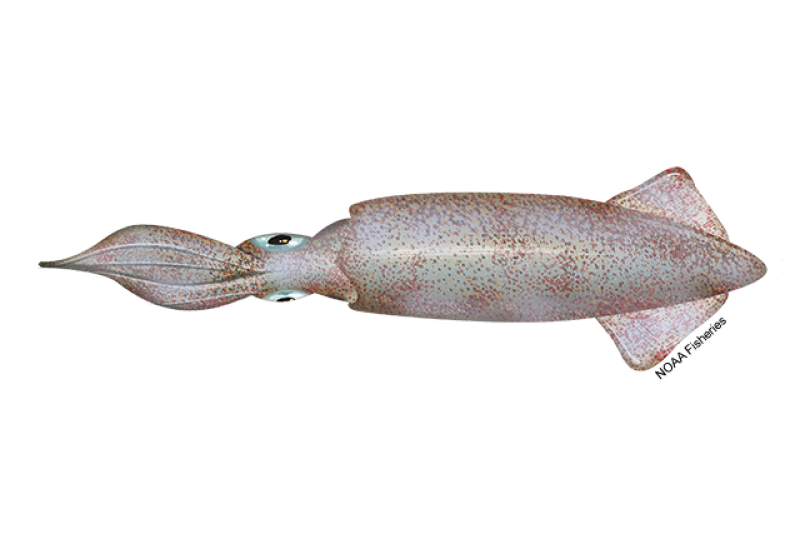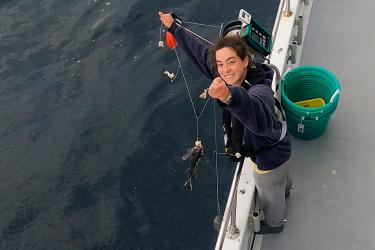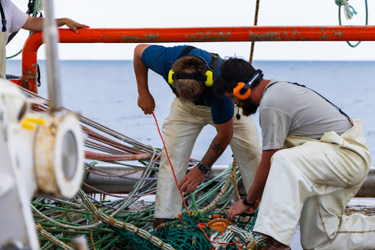Shortfin Squid
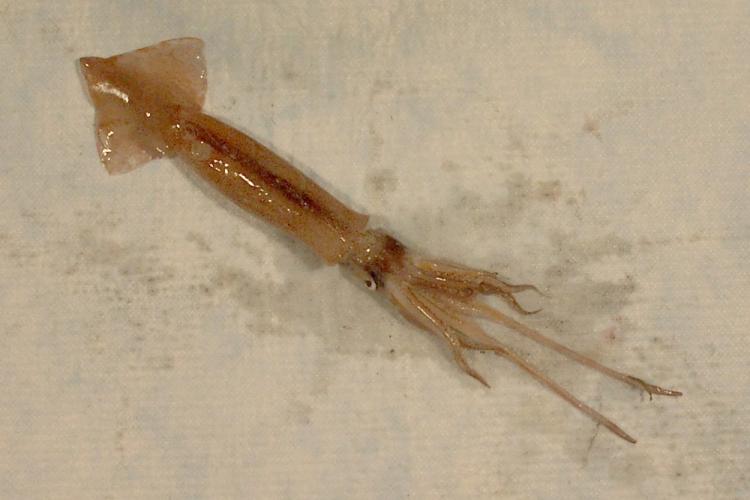 Shortfin squid. Credit: NOAA Fisheries
Shortfin squid. Credit: NOAA Fisheries
Shortfin squid. Credit: NOAA Fisheries
About the Species
 Shortfin squid. Credit: NOAA Fisheries
Shortfin squid. Credit: NOAA Fisheries
Shortfin squid. Credit: NOAA Fisheries
U.S. wild-caught shortfin squid is a smart seafood choice because it is sustainably managed and responsibly harvested under U.S. regulations.

Population
The population level is unknown, but management measures are in place.

Fishing Rate
Not subject to overfishing.

Habitat Impact
Fishing gears used to harvest shortfin squid have minimal impacts on habitat.

Bycatch
Regulations are in place to minimize bycatch.
Population Status
- According to the latest assessment (2005 stock assessment), shortfin squid is not subject to overfishing. There is currently not enough information to determine the population size, so it is unknown. Summary stock assessment information can be found on Stock SMART.
Appearance
- Female shortfin squid range from 7 to 12 inches in mantle length, while males are 7 to 10.6 inches in mantle length.
- They can regulate their body color, but are primarily orange-colored with a brown stripe that extends along the top side of the mantle.
Biology
- Shortfin squid live for less than one year. They have a high natural mortality rate, and a long spawning season.
- Females can release multiple egg masses during a single spawning season, but die after they spawn. Spawning can occur year round with seasonal peaks from October to June.
- Shortfin squid have extremely variable birth, growth, and maturity rates. This makes them extremely sensitive to climate-driven changes.
- They grow about one millimeter a day.
- Shortfin squid are visual predators that eat crustaceans, fish, and other squid, including their own species.
- They are food for many fish, including bluefin tuna, silver hake, red hake, bluefish, goosefish, fourspot flounder, Atlantic cod, sea raven, spiny dogfish, and swordfish. Seabird predators include shearwaters, gannets, and fulmars.
- Shortfin squid undergo daily vertical migrations between cooler deep water and warmer surface water. They are nearest the seabed during the day, and higher in the water column during the night.
Where They Live
Range
- Shortfin squid inhabits the continental shelf and slope waters of the Northwest Atlantic Ocean, from Newfoundland to the central east coast of Florida.
- In the northwest Atlantic Ocean, shortfin squid are most often caught along the continental shelf break in depths between 150 to 275 meters.
Habitat
- Shortfin squid live in deep and shallow waters on the continental shelf, continental slope, and open ocean depending on the season.
- They are found in nearshore waters of the Gulf of Maine during summer and fall.
- During spring, shortfin squid migrate onto the continental shelf, and during late fall, they migrate off the continental shelf.
- Their egg masses float in mid-water.
- Spawning occurs in the waters off Rhode Island and New Jersey.
Fishery Management
- NOAA Fisheries and the Mid-Atlantic Fishery Management Council manage the shortfin squid fishery.
- Managed under the Atlantic Mackerel, Squid, and Butterfish Fishery Management Plan:
- Fishermen with a limited access permit can fish for unlimited amounts of shortfin squid while the fishery is open. All other fishermen must obtain an incidental catch permit, and have possession limits.
- An annual coastwide catch quota is set annually. Managers monitor annual quotas closely, as there can be large fluctuations in abundance from year to year.
Harvest
- Commercial fishery
- In 2023, commercial landings of shortfin squid totaled 12 million pounds, and were valued at $6 million according to the NOAA Fisheries commercial fishing landings database.
- Fisheries for shortfin squid reflect the species’ seasonal migrations.
- The majority of landings come from Rhode Island and New Jersey.
- Harvested for bait domestically, and exported for bait and food.
- Gear types, habitat impacts, and bycatch:
- The majority of shortfin squid is harvested June 1 through October 31 using small-mesh bottom trawls. The fishery is open year round, but the squid aren’t available in commercial quantities year round.
- Sandy or muddy habitat, where squid are fished, is less sensitive to the impacts of trawling.
- Small-mesh bottom trawls can incidentally catch marine mammals and large pelagic species, including pilot whales, common dolphin, swordfish, and a variety of sharks, ray, and tuna species. Finfish such as butterfish, hakes, longfin squid, summer flounder, herring, spiny dogfish, and Atlantic mackerel are also incidentally caught in this fishery.
- Measures to prevent or minimize bycatch include:
- Fishing must occur seaward of the 50-fathom depth line to reduce finfish and longfin inshore squid bycatch.
- Outreach to fishermen to educate them on actions to take in the event of a marine mammal interaction.
- Real-time communication to vessels regarding hotspots of marine mammal interactions.
Scientific Classification
- Shortfin squid inhabits the continental shelf and slope waters of the Northwest Atlantic Ocean, from Newfoundland to the central east coast of Florida.
- In the northwest Atlantic Ocean, shortfin squid are most often caught along the continental shelf break in depths between 150 to 275 meters.
- Shortfin squid live in deep and shallow waters on the continental shelf, continental slope, and open ocean depending on the season.
- They are found in nearshore waters of the Gulf of Maine during summer and fall.
- During spring, shortfin squid migrate onto the continental shelf, and during late fall, they migrate off the continental shelf.
- Their egg masses float in mid-water.
- Spawning occurs in the waters off Rhode Island and New Jersey.
Fishery Management
- NOAA Fisheries and the Mid-Atlantic Fishery Management Council manage the shortfin squid fishery.
- Managed under the Atlantic Mackerel, Squid, and Butterfish Fishery Management Plan:
- Fishermen with a limited access permit can fish for unlimited amounts of shortfin squid while the fishery is open. All other fishermen must obtain an incidental catch permit, and have possession limits.
- An annual coastwide catch quota is set annually. Managers monitor annual quotas closely, as there can be large fluctuations in abundance from year to year.
Harvest
- Commercial fishery
- In 2023, commercial landings of shortfin squid totaled 12 million pounds, and were valued at $6 million according to the NOAA Fisheries commercial fishing landings database.
- Fisheries for shortfin squid reflect the species’ seasonal migrations.
- The majority of landings come from Rhode Island and New Jersey.
- Harvested for bait domestically, and exported for bait and food.
- Gear types, habitat impacts, and bycatch:
- The majority of shortfin squid is harvested June 1 through October 31 using small-mesh bottom trawls. The fishery is open year round, but the squid aren’t available in commercial quantities year round.
- Sandy or muddy habitat, where squid are fished, is less sensitive to the impacts of trawling.
- Small-mesh bottom trawls can incidentally catch marine mammals and large pelagic species, including pilot whales, common dolphin, swordfish, and a variety of sharks, ray, and tuna species. Finfish such as butterfish, hakes, longfin squid, summer flounder, herring, spiny dogfish, and Atlantic mackerel are also incidentally caught in this fishery.
- Measures to prevent or minimize bycatch include:
- Fishing must occur seaward of the 50-fathom depth line to reduce finfish and longfin inshore squid bycatch.
- Outreach to fishermen to educate them on actions to take in the event of a marine mammal interaction.
- Real-time communication to vessels regarding hotspots of marine mammal interactions.
Scientific Classification
| Kingdom | Animalia | Phylum | Mollusca | Class | Cephalopoda | Order | Oegopsida | Family | Ommastrephidae | Genus | Illex | Species | illecebrosus |
|---|
Last updated by NOAA Fisheries on 09/17/2025
Featured News
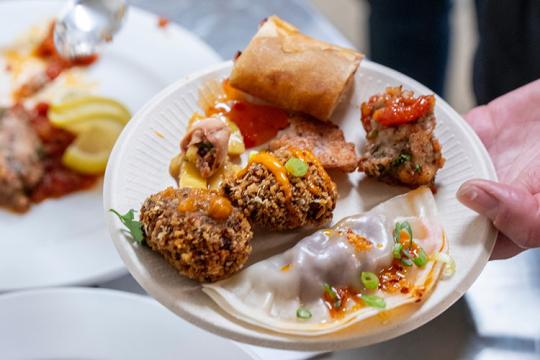 A chef prepares various finger foods made from squid fins in the Dr. Matthew Highlands Food Pilot Plant in Hitchner Hall at the University of Maine. Several chefs were invited to create dishes as part of a research project to develop new frozen foods made from squid fins. Photo courtesy of the University of Maine.
A chef prepares various finger foods made from squid fins in the Dr. Matthew Highlands Food Pilot Plant in Hitchner Hall at the University of Maine. Several chefs were invited to create dishes as part of a research project to develop new frozen foods made from squid fins. Photo courtesy of the University of Maine.
Recreational Fishing Regulations
Vessel Permits
For-Hire (Charter/Party) Recreational Fishing
In order to fish for, possess, or land shortfin (Illex) squid in or from federal waters on a for-hire recreational fishing trip, a vessel must have been issued (and carry on board) a Category 2 Squid/Mackerel/Butterfish Charter Party Permit.
Private Recreational Fishing
Anglers aged 16 or older need a permit to fish in federal waters. All of the states in the Greater Atlantic Region also have saltwater fishing license and/or registration requirements. You should obtain your license from the state you fish from that will meet both of these requirements. If you fish from multiple states, you may need a permit from each.
Possession Limits
There is no recreational possession limit for Illex squid.
Fish Size Limits
None.
Fishing Season
Year-round.
Reporting A Recreational Catch
Catch Reporting and Electronic Vessel Trip Reports (eVTR)
Owners/operators of federally-permitted for-hire vessels (including vessels issued a Category 2 Squid/Mackerel/Butterfish Charter Party Permit) are required to submit an eVTR for every fishing trip. This is true for all trips, no matter where the vessel was fishing (state or federal waters) or what species was being fished for or caught (even if no fish were landed). eVTRs must have all effort and catch information completed before offloading, and they must be submitted to NOAA Fisheries within 48 hours of the conclusion of the trip. For more information, please see our Vessel Trip Reporting in the Greater Atlantic Region webpage.
Other Reporting Information
The recreational Illex squid fishery does not have any Interactive Voice Response (IVR), Vessel Monitoring System (VMS), or specific observer requirements. However, all federally permitted vessels are obligated to carry an observer if randomly selected by the National Observer Program.
Reporting is not required for the private recreational fishery, but the Marine Recreational Information Program (MRIP) is a system of voluntary coordinated data collection programs designed to estimate recreational catch and effort.
Last updated by NOAA Fisheries on 09/17/2025
Commercial Fishing Regulations
Vessel Permits
In order to fish for, possess, or land shortfin (Illex) squid in or from federal waters on a commercial fishing trip, a vessel must have been issued (and carry on board) a Category 5 Illex Squid Moratorium Permit or a Category 3 Squid/Butterfish Incidental Catch Permit.
Fishery Specifications
2024 Illex squid specifications were implemented through the final rule setting 2024-2026 specifications for the Mackerel, Squid, and Butterfish Fishery Management Plan (FMP), effective August 22, 2024. These specifications will continue to roll over into 2025 until they are replaced by new ones.
2024 Illex Squid Specifications
Specification | Metric Tons (mt) |
Overfishing limit (OFL) | Unknown |
Acceptable biological catch (ABC) | 40,000 |
Commercial discard set-aside | 1,369 (3.42%) |
Initial optimum yield (IOY) | 38,631 |
Domestic annual harvest (DAH)/domestic annual processing (DAP) | 38,631 |
Possession Limits
2024 Illex Squid Possession Limits by Vessel Permit Category
| Permit Category | Illex Squid | Longfin Squid | Butterfish |
| SMB 3 Squid/Butterfish Incidental | 10,000 lb | 250 lb | 600 lb |
| SMB 5 Illex Squid Moratorium Permit | Unlimited | - | - |
Fish Size Limits
None.
Accountability Measures
When NOAA Fisheries projects that 94 percent of the Illex squid DAH has been harvested in a given fishing year, the Illex squid possession limit for limited access vessels will be reduced to 10,000 lb per trip for the remainder of the fishing year (through December 31).
Reporting A Commercial Catch
Catch Reporting and Electronic Vessel Trip Reports (eVTR)
Owners/operators of federally-permitted commercial vessels (including vessels issued a commercial Illex squid permit) are required to submit an eVTR for every fishing trip. This is true for all trips, no matter where the vessel was fishing (state or federal waters) or what species was being fished for or caught (even if no fish were landed). eVTRs must have all effort and catch information completed before offloading, and they must be submitted to GARFO within 48 hours of the conclusion of the trip. For more information, please see our Vessel Trip Reporting in the Greater Atlantic Region webpage.
Interactive Voice Response (IVR) Requirements
The Atlantic mackerel, squid, and butterfish fisheries do not have any IVR requirements. However, if you are participating in a research program such as research set-aside (RSA) or fishing with an exempted fishing permit (EFP), there are IVR requirements. Please refer to your RSA or EFP paperwork for instruction on using IVR.
Vessel Monitoring System (VMS) Requirements
The owner or operator of a vessel issued a limited access Illex squid permit must report catch (retained and discarded) of Illex squid daily via VMS. Daily VMS catch reports must be submitted in 24-hr intervals for each day, and must be submitted by 0900 hr on the following day. Reports are required even if Illex squid caught that day have not yet been landed.
Commercial Gear Information
The Northeast multispecies (groundfish) regulations divide the Greater Atlantic Region into four regulated mesh areas (RMAs): Gulf of Maine, Georges Bank, Southern New England, and Mid-Atlantic. There are different gear requirements (minimum mesh sizes, maximum number of hooks, etc) for each RMA. For detailed information about the gear requirements associated with each RMA, please see the federal groundfish RMA and gear regulations. For a summary of the Illex squid-related exemptions to these gear regulations, please see our Illex squid exempted fishing webpage.
Net Obstruction or Constriction
The mackerel, squid, and butterfish gear regulations include restrictions on mesh obstruction or constriction. Vessels fishing with trawl gear may not use any mesh construction, mesh configuration, or other means that effectively decreases mesh size below the minimum required size, except that a liner may be used to close the opening created by the rings in the aftermost portion of the net, provided the liner extends no more than 10 meshes forward of the aftermost portion of the net. The inside webbing of the codend shall be the same circumference or less than the outside webbing (strengthener). In addition, the inside webbing shall not be more than 2 feet longer than the outside webbing.
Illex Squid Exemption Area: Gear Exemptions
Otter trawl vessels possessing longfin squid harvested in or from federal waters and fishing for Illex) squid during the months of June, July, August in Trimester II, and September in Trimester III, are exempt from the longfin squid gear requirements specified at 50 CFR 648.23(a)(2), as long as the following conditions are met when the vessel is landward of the Illex Squid Exemption Area:
- Any net, or any piece of net, with a diamond mesh size less than 1 ⅞ inches in Trimester II, and 2 ⅛ inches in Trimester III, is stowed and not available for immediate use.
- Any net, or any piece of net, equipped with a net strengthener with a mesh opening smaller than 5 inches (diamond or square mesh) is stowed and not available for immediate use.

Last updated by NOAA Fisheries on 09/17/2025
Seafood Facts

Is Shortfin Squid Sustainable?
U.S. wild-caught shortfin squid is a smart seafood choice because it is sustainably managed and responsibly harvested under U.S. regulations.
Availability
Summer and fall.
Source
U.S. wild-caught from Maine to North Carolina.
Taste
Mild, and subtly sweet.
Texture
Firm and meaty.
Color
Raw squid is ivory colored with orange speckling and a brown stripe that runs down the mantle. Cooked squid is opaque white.
Health Benefits
Squid are an excellent source of selenium, riboflavin, and vitamin B12.
Nutrition Facts
Servings: 1; Serving Weight: 100 g; Calories: 92; Protein: 15.58 g; Total Fat: 1.38 g; Total Saturated Fatty Acids: 0.358 g; Carbohydrate: 3.08 g; Total Sugars: 0 g; Total Dietary Fiber: 0 g; Cholesterol: 233 mg; Selenium: 44.8 mcg; Sodium: 44 mgMore Information
Squid (Calamari) Recipes
Looking for some ways to add squid into your rotation? If you need cooking inspiration, browse these recipes for squid chowder, classic fried calamari, and more!

Last updated by NOAA Fisheries on 09/17/2025
Seafood News
 Thomas Piecuch flips floating oyster bags on his farm (Credit: Holy Ground Oyster Company).
Thomas Piecuch flips floating oyster bags on his farm (Credit: Holy Ground Oyster Company).
Celebrating Aquaculture Week: Farming from Tide to Table
 NOAA team members adjust a prototyped turtle excluder device (TED) before sending it to divers below for continued testing on the NOAA R/V Caretta. Credit: NOAA Fisheries (ESA Permit 20339)
NOAA team members adjust a prototyped turtle excluder device (TED) before sending it to divers below for continued testing on the NOAA R/V Caretta. Credit: NOAA Fisheries (ESA Permit 20339)
Small Modifications to Turtle Excluder Devices Have Big Impacts for Gulf Sea Turtles
 Pacific oysters travel down a sorting tumbler at Salty Lady Seafood Company in Juneau, Alaska. Credit: Salty Lady Seafood Company.
Pacific oysters travel down a sorting tumbler at Salty Lady Seafood Company in Juneau, Alaska. Credit: Salty Lady Seafood Company.
 Commercial fishing boats lined up in Sitka, Alaska. Credit: Shutterstock.
Commercial fishing boats lined up in Sitka, Alaska. Credit: Shutterstock.
NOAA Fisheries Seeks Recommendations for Restoring American Seafood Competitiveness
Closed and Restricted Areas
This page provides a broad overview of the closed and gear restricted areas that apply to the shortfin (Illex) squid fishery.
Oceanographer Canyon and Lydonia Canyon
Mackerel, squid, and butterfish vessels are prohibited from fishing with bottom trawl gear in Oceanographer Canyon or Lydonia Canyon, or being in Oceanographer or Lydonia Canyon unless transiting. Vessels may only transit these areas if bottom trawl gear is stowed and not available for immediate use. These restrictions are in place year-round.
Scup Gear Restricted Areas (GRA)
The Fluke, Scup, and Black Sea Bass Fishery Management Plan (FMP) includes two gear restricted areas (GRA) that apply during different periods during the year. These GRAs impact vessels fishing for longfin squid, which can overlap with the Illex squid fishery.
Scup GRA Details
November 1 – December 31 | January 1 – March 15 |
Minimum mesh size of 5.0 inch diamond mesh | Minimum mesh size of 5.0 inch diamond mesh |
Transit allowed if codends less than 5.0 inches are stowed and not available for immediate use. | Transit allowed if codends less than 5.0 inches are stowed and not available for immediate use. |

Frank R. Lautenberg Deep-Sea Coral Protection Areas
Northeast Multispecies (Groundfish) Closed Areas
The Northeast Multispecies FMP includes a number of closed areas that apply to vessels fishing for Illex squid. For an overview of these areas, please see our groundfish closed areas webpage.
More Information
Last updated by NOAA Fisheries on 09/17/2025
Exempted Fishing
The Northeast Multispecies (Groundfish) Fishery Management Plan includes gear requirements for each regulated mesh area (RMA) in the Greater Atlantic Region. In some cases, there are exemptions from these gear requirements for vessels fishing for Illex squid. A Letter of Authorization (LOA) from the Regional Administrator is required to fish under some of these exemptions. You can apply for an LOA through your Fish Online account. If you need help with the online application or setting up an account, or have any other questions about the online forms and applications, please contact our Permits Office at (978) 282‐8438 between 8 a.m. and 4:30 p.m. ET or email NMFS.GAR.Permits@noaa.gov.
Midwater Trawl Gear Exempted Fishery
Vessels may fish with midwater trawl gear equipped with mesh smaller than the applicable minimum size, as long as they meet the following conditions:
- The vessel fishes exclusively with midwater trawl gear.
- The vessel carries an observer, if requested by the Regional Administrator.
- When fishing in the Gulf of Maine/Georges Bank Exemption Area:
- The vessel is issued an LOA (minimum 7-day duration).
- The vessel only fishes for, possesses, or lands Atlantic herring, blueback herring, or mackerel north of 42°20′ N latitude, in Closed Area I North, and in Closed Area II.
- The vessel only fishes for, possesses, or lands Atlantic herring, blueback herring, mackerel, or squid south of 42°20′ N latitude.
- The vessel does not fish for, possess, or land groundfish, except:
- A vessel issued a Category A or B herring permit fishing on a declared herring trip may possess and land haddock and other regulated groundfish, consistent with the applicable catch caps and possession restrictions. Haddock that has been brought or pumped into the hold may not be discarded.
- A vessel issued a Category C, D, or E herring permit fishing with midwater trawl gear may possess and land haddock and other regulated groundfish, consistent with the applicable catch caps and possession restrictions. Haddock that has been brought or pumped into the hold may not be discarded.
- Such haddock and other regulated groundfish may not be (or may not attempt to be) sold, purchased, received, traded, bartered, transferred for, or intended for human consumption.
- Haddock and other regulated groundfish that are separated out from the herring catch by dealers/processors may not be (or may not attempt to be) sold, purchased, received, traded, bartered, or transferred for any purpose.
- The vessel must submit a pre-trip notification to NOAA Fisheries at least 48 hrs prior to beginning a trip if:
- The vessel is issued a Category A or B herring permit and is fishing on a declared herring trip; or
- The vessel is issued a Category C, D, or E herring permit and is fishing with midwater trawl gear in Herring Management Area 1A, 1B, or 3.
- The vessel must submit a pre-landing notification to NOAA Fisheries at least 6 hrs prior to landing (or as soon as the vessel stops catching fish, if fishing ends less than 6 hrs before landing), if:
- The vessel is issued a Category A or B herring permit and is fishing on a declared herring trip with midwater trawl gear; or
- The vessel is issued a Category C or E herring permit and is fishing with midwater trawl gear in Herring Management Area 1A, 1B, or 3.
Purse Seine Gear Exempted Fishery
Vessels may fish with purse seine gear equipped with mesh smaller than the applicable minimum size, as long as they meet the following conditions:
- The vessel fishes exclusively with purse seine gear.
- The vessel carries an observer, if requested by the Regional Administrator.
- When fishing in the Gulf of Maine/Georges Bank Exemption Area:
- The vessel is issued an LOA (minimum 7-day duration).
- The vessel only fishes for, possesses, or lands Atlantic herring, blueback herring, mackerel, or menhaden.
- The vessel does not fish for, possess, or land groundfish, except:
- A vessel issued a Category A or B herring permit fishing on a declared herring trip may possess and land haddock and other regulated groundfish, consistent with the applicable catch caps and possession restrictions. Haddock that has been brought or pumped into the hold may not be discarded.
- Such haddock and other regulated groundfish may not be (or may not attempt to be) sold, purchased, received, traded, bartered, transferred for, or intended for human consumption.
- Haddock and other regulated groundfish that are separated out from the herring catch by dealers/processors may not be (or may not attempt to be) sold, purchased, received, traded, bartered, or transferred for any purpose.
- The vessel must submit a pre-trip notification to NOAA Fisheries at least 48 hrs prior to beginning a trip if the vessel is issued a Category A or B herring permit.
- The vessel must submit a pre-landing notification to NOAA Fisheries at least 6 hrs prior to landing (or as soon as the vessel stops catching fish, if fishing ends less than 6 hrs before landing), if the vessel is issued a Category A or B herring permit.
Gulf of Maine and Georges Bank Small-Mesh Exemption Areas
Vessels may fish for whiting using small-mesh bottom trawl gear in the exemption areas listed below, as long as they meet the following conditions:
- Vessels must comply with all applicable season, area, and gear requirements.
- Vessels must comply with all applicable possession limits.
- Vessels must be issued a whiting (Category K Open Access Northeast Multispecies) permit or a limited access Northeast multispecies permit.
Vessels fishing for whiting in some of these exemption areas may only retain squid as incidental catch while fishing for whiting (they may not target squid).
Small-Mesh Exemption Areas Details
Area | Season | LOA Required | Squid as Incidental Catch Only? |
Gulf of Maine Grate Raised Footrope Trawl Whiting Fishery Exemption Area |
July 1 – November 30
| No | Yes |
June 15 – October 31
| Yes | Yes | |
Small-Mesh Area 1: July 15 – November 15
Small-Mesh Area 2: January 1 – June 30 | No | No (may target) | |
Raised Footrope Trawl Exempted Whiting Fishery Areas (Cape Cod) | September 1 – November 20; September 1 – December 31
| Yes | Yes |

Southern New England Exemption Area
Vessels may fish for, harvest, possess, or land Illex squid (as well as certain other species) using nets equipped with mesh smaller than the applicable minimum size in the Georges Bank or Southern New England RMAs when fishing in the Southern New England Exemption Area, provided they comply with all applicable gear stowage requirements and possession restrictions.

Last updated by NOAA Fisheries on 09/17/2025
Management Overview
Who manages this fishery?
In federal waters, shortfin (Illex) squid is jointly managed by NOAA Fisheries and the Mid-Atlantic Fishery Management Council. Generally, "federal waters" refers to the portion of the ocean between 3 and 200 nautical miles from shore.
How is this fishery managed?
The Illex squid fishery is managed through the use of permits, possession limits, annual quotas, gear restricted areas, and accountability measures.
What is the fishing year for this fishery?
January 1–December 31.
What are the different management areas for this fishery?
Illex squid is managed as a single stock in the Greater Atlantic Region.
Where does this fishery occur?
Illex squid is predominantly caught in the Greater Atlantic Region from Rhode Island to New Jersey.
Management Plans
Atlantic mackerel, longfin squid, Illex squid, butterfish, and Atlantic chub mackerel are managed in federal waters under the Atlantic Mackerel, Squid and Butterfish Management Plan (FMP).
Regulatory History
Completed Actions
1978: Atlantic Mackerel FMP established management of Atlantic mackerel fishery
1978: Atlantic Butterfish FMP established management of Atlantic butterfish fishery
1978: Squid FMP established management of squid fisheries
1979: Atlantic Mackerel Amendment 1 continued management of the Atlantic mackerel fishery
1979: Squid Amendment 1 continued management of the squid fishery
1980: Atlantic Butterfish Amendment 1 continued management of the Atlantic butterfish fishery
1980: Atlantic Mackerel Amendment 2 continued management of the Atlantic mackerel fishery.
1980: Atlantic Butterfish Amendment 2 continued management of the Atlantic butterfish fishery.
1983: Merged FMP consolidated management of Atlantic mackerel, squid, and butterfish fisheries under a single FMP.
1984: Amendment 1 implemented squid OY adjustment mechanism and revised the Atlantic mackerel mortality rate.
1986: Amendment 2 revised squid bycatch TALFF allowances, implemented framework adjustment process, converted expiration of fishing permits from indefinite to annual, and equated fishing year with calendar year.
1991: Amendment 3 established overfishing definitions for all four species.
1991: Amendment 4 limited the activity of directed foreign fishing and joint venture transfers to foreign vessels and allowed for specification of OY for Atlantic mackerel for up to three years.
1996: Amendment 5 adjusted Loligo MSY; eliminated directed foreign fisheries for Loligo, Illex, and butterfish; instituted a dealer and vessel reporting system; instituted an operator permitting system; implemented a limited access system for Loligo, Illex and butterfish; and expanded the management unit to include all Atlantic mackerel, Loligo, Illex, and butterfish under U.S. jurisdiction.
1997: Amendment 6 revised the overfishing definitions for Loligo, Illex, and butterfish; established directed fishery closure at 95 percent of DAH for Loligo, Illex and butterfish with post-closure trip limits for each species; and established a mechanism for seasonal management of the Illex fishery to improve the yield-per recruit.
1997: Amendment 7 established consistency among FMPs in the NE region of the U.S. relative to vessel permitting, replacement and upgrade criteria.
1998: Amendment 8 brought the FMP into compliance with new and revised National Standards and other required provisions of the Sustainable Fisheries Act. This action also added a framework adjustment procedure.
2001: Framework 1 (PDF, 80 pages) created a quota set-aside for the purpose of conducting scientific research
2002: Framework 2 (PDF, 4 pages) extended the moratorium on entry to the Illex fishery for an additional year; established that previous year specifications apply when specifications for the management unit are not published prior to the start of the fishing year (excluding TALFF specifications); and allowed for the specification of management measures for Loligo for a period of up to three years.
2003: Framework 3 (PDF, 3 pages) extended the moratorium on entry to the Illex fishery for an additional year.
2004: Framework 4 extended the moratorium on entry to the Illex fishery for an additional five years
2007: Amendment 12 implemented standardized bycatch reporting methodology.
2008: Amendment 9 allowed for multi-year specifications for all four managed species (mackerel, butterfish, Illex, and Loligo) for up to 3 years; extended the moratorium on entry into the Illex fishery, without a sunset provision; adopted biological reference points for Loligo recommended by the stock assessment review committee (SARC); designated EFH for Loligo eggs based on available information; and prohibited bottom trawling by MSB-permitted vessels in Lydonia and Oceanographer Canyons.
2010: Amendment 10 implemented a butterfish rebuilding program, increased the Loligo minimum mesh in Trimesters 1 and 3, and implemented a 72-hour trip notification requirement for the Loligo fishery.
2010: Amendment 13 implemented Annual Catch Limits (ACLs), Annual Catch Targets (ACTs), and Accountability Measures (AMs).
2011: Amendment 11 implemented Limited Access in the Atl. mackerel fishery, updated EFH for all MSB species, and established a recreational-commercial allocation.
2012: Framework 5 broadened the scope of individuals who can perform hold measurements for limited access mackerel vessels
2012: Framework 6 clarified the Council's risk policy and describes the limited circumstances under which acceptable biological catch (ABC) can be increased for stocks without status determination criteria on overfishing.
2013: Framework 7 converted the butterfish mortality cap from a catch cap to a discard cap
2014: Amendment 14 implemented a variety of reporting and monitoring requirements for Atlantic mackerel and longfin squid fisheries, and implemented a river herring and shad catch cap for the Atlantic mackerel fishery (Appendices). Final Rule.
2013: Amendment 17 modified accountability measures for the Council's recreational fisheries, including Atlantic mackerel. Final Rule.
2014: Framework 8 implemented changes to improve operation of the butterfish discard cap in the longfin squid fishery and the directed butterfish fishery. Final Rule.
2015: Amendment 15 implemented Standardized Bycatch Reporting Methodology. Final Rule.
2015: Amendment 19 eliminated the requirement for vessel owners to submit "did not fish" reports for the months or weeks when their vessel was not fishing. This action also removed some of the restrictions for upgrading vessels listed on Federal fishing permits. Final Rule.
2015: Framework 9 established measures to enhance catch monitoring and address slippage (catch that is discarded before it has been sampled by observers) in the Atlantic mackerel fishery.
2016: Amendment 16 - Deep Sea Corals Amendment established management measures to protect deep sea corals from the impacts of commercial fishing gear in the Mid-Atlantic region. Final Rule.
2017: Amendment 18 - Unmanaged Forage Omnibus Amendment implemented management measures to prevent the development of new, and the expansion of existing, commercial fisheries on certain forage species in the Mid-Atlantic. Final Rule.
2017: Framework 10 - Omnibus For-Hire Electronic Trip Reporting Framework implemented a requirement for vessels that hold party/charter permits for Council-managed species to submit vessel trip reports electronically (eVTRs) while on a trip carrying passengers for hire.
2018: Framework 11 - Omnibus Acceptable Biological Catch Framework established a process for setting constant multi-year Acceptable Biological Catch (ABCs) limits for Council-managed fisheries; clarified that the Atlantic Bluefish, Tilefish, and Atlantic Mackerel, Squid, and Butterfish FMPs will now automatically incorporate the best available scientific information in calculating ABCs (as all other Mid-Atlantic management plans do) rather than requiring a separate management action to adopt them; clarified the process for setting ABCs for each of the four types of ABC control rules. Final Rule.
2018: Amendment 20 - Squid Amendment reduced latent directed permits, created limited access incidental permits, and lowered Trimester 2 post-closure trip limit to 250 pounds to discourage directed fishing after closures. Final Rule.
2018: Framework 12 - Atlantic Mackerel Closure Provisions Framework allowed the possession of 5,000 lb of Atlantic mackerel after 100 percent of the domestic annual harvest is caught instead of prohibiting the possession of Atlantic mackerel for the rest of the year. Final Rule.
2019: Framework 13 - Established a 5-year rebuilding plan for Atlantic mackerel, set 2019-2021 mackerel specifications, modified the Mid-Atlantic Council’s risk policy, and modified in-season closure measures for mackerel. Final Rule.
2020: Amendment 21 - Chub Mackerel Amendment established management of Atlantic chub mackerel through the Mackerel, Squid, and Butterfish FMP. Final Rule.
2020: Framework 14 - Omnibus Commercial Electronic Reporting Framework established a requirement for commercial vessels with federal permits for Mid-Atlantic and New England Council-managed species to submit eVTRs within 48 hrs after the conclusion of a trip. Final Rule.
2020: Framework 15 - Omnibus ABC and Risk Policy Framework modified the Mid-Atlantic Council’s ABC control rule and risk policy. Final Rule.
2023: Amendment 23 - Atlantic Mackerel Rebuilding 2.0 Amendment revised the rebuilding plan for mackerel, set 2023 mackerel fishery specifications, established a recreational possession limit for mackerel, and modified in-season closure measures for mackerel to include an initial closure with different thresholds based on time of year (before vs. on/after May 1) and a final closure when the fishery is close to harvesting the full commercial quota. Final Rule.
2024: Framework 16 - Illex Hold Framework established a hold capacity baseline requirement for limited access Illex squid vessels, allowed NOAA Fisheries to collect processing type information from limited access Illex and Tier 1 longfin squid vessels, and clarified existing VMS requirements.
Under Development
None at this time.
More Information
Last updated by NOAA Fisheries on 09/17/2025
Science Overview
NOAA Fisheries conducts various research activities on the biology, behavior, and population health of shortfin (Illex) squid. The results of this research are used to inform management decisions for this species.
For detailed information about stock status, management, assessments, and resource trends, you can search for Illex squid, and any other species of interest, using NOAA’s StockSMART web tool.
Stock Assessment Review Index
Fishery Stock Assessments in New England and the Mid-Atlantic provides general information about stock assessments, and the Stock Assessment Review Index contains copies of completed assessment documents.
Last updated by NOAA Fisheries on 09/17/2025
Data & Maps
Research
Oceanographic Drivers of Shortfin Squid
We’re working with the commercial squid fishing industry to better understand how ocean conditions and processes influence the variability of shortfin squid catch in the Mid-Atlantic.
Ecosystem and Socioeconomic Profile Development and Reports
Status of Ecosystem and Socioeconomic Profiles for Northeast fishery stock assessments.
Last updated by NOAA Fisheries on 09/17/2025



